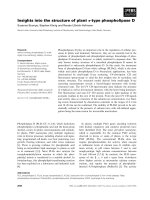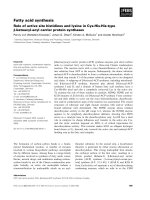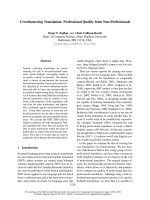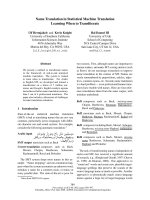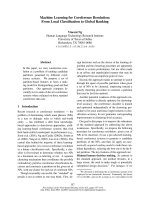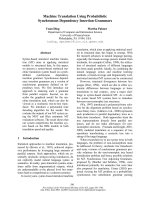Báo cáo khoa học: "MACHINE TRANSLATION : WHAT TYPE OF POST-EDITING ON WHAT TYPE OF DOCUMENTSFOR WHAT TYPE OF USERS" pdf
Bạn đang xem bản rút gọn của tài liệu. Xem và tải ngay bản đầy đủ của tài liệu tại đây (213.46 KB, 3 trang )
MACHINE TRANSLATION : WHAT TYPE OF POST-EDITING
ON WHAT TYPE OF DOCUMENTS FOR WHAT TYPE OF USERS
Anne-Marie LAURIAN
Centre National de la Recherche Scientifique
Universitd de la Sorbonne Nouvelle - Paris III
19 rue des 8ernardins, 75005 Paris (France)
ABSTRACT
Various typologies of technical and
seientifical texts nave already been proposeO
bv authors involved in multilingual transfer
problems. They were usually aimed at a better
knowledge of the criteria for deciding if a
document has to be or can be machine trans-
lated. Such a typology could also lead to a
better knowledge of the typical errors oc-
curing, and so lead to more appropriate
post-editing, as well as to improvements in
the system.
Raw translations being usable, as they
are quite often for rapid information needs,
it is important to draw the limits between a
style adequate for rapid information, and an
elegant, high qualitv style such as required
for information large dissemination. Style
could be given a new definition through a
linguistic analysis based on machine trans-
lation, on communication situations and on
the users' requirements and satisfaction.
I. MACHINE TRANSLATION AND POST-EDITING,
A EUROPEAN EXAMPLE
Machine translation is often considered
as a project, an experimental process, if not
an impossible dream. Translation theoreti-
clans would sav no machine can understand the
meaning of a text and re-express it in an
other language, so no machine can translate.
The debate is about the necessity of a deep
semantic understanding for translating,
opposed to a language structure knowledge to
be sufficient to produce a translation. The
usual debate is thus about the ideal concept
each one has of what a translation should be.
Translation can only be defined in
particular situations, regarding particular
documents. And machine translation is only to
be used for certain types of documents to be
handled a certain way.
HY observations are based on several
studies I carried out on the SYSTRAN output
produced in Luxembourg within the Commission
of the European Communities.
In Luxembourg the amount of documents to
be translated is not only very big, it is
also growing very fast. The european rule is
that all official documents have to be
translated into the seven official languages;
technical documents needed for conferences or
experts meetings are sometimes translated
only in three or four languages (english,
french, german, italian). The delay available
is often very short. That led the C.E.C.
General Direction for Multilingual Transfers
to promote machine translation. When they
started it, some six years ago, SYSTRAN was
the only system ready to produce transla-
tions. This system, originated in the U.S.,
has then been developed for the proper use of
the Commission.
The output was far from being perfect,
far from being usable as it was. Post-editing
was being done. Even with the huge progress
of the output quality, post-editing is still
necessarY. It will, in fact, be always
necessary because as people get used to their
translation to be done by a computer, their
requirements are becoming more precise. The
errors one would admit at an experimental
stage, are no more possible at a productive
stage.
Post-editing is thus becoming a new
specialization within the numerous fields
related to translation.
I; - A TYPOLOGY OF
DOCUMENTS
BASED ON M.T. ERRORS
All documents are not suitable for
machine translation. Lots of negative
reactions against M.T. have been induced by a
wrong use of M.T. Aware of the necessity of
differentiating the documents, people res-
ponsible for translation proposed several
types of typologies. They were mainly based
on the subject field of the text, on its
function, on its structure, on the sentence
and paragraph length and complexity, on the
use of particular terminologies.
236
The aim was to enable the chief of a
translation division to choose which texts
were to be sent to a human translator, and
which could be processed by M.T.
My study of the errors remaining in the
raw translations led me to propose a strictly
linguistic typology. I
There are three major tvpes of errors :
i. errors on isolated words,
2. errors on the expression of relations,
3. errors on the structure and on the
information display.
These errors are classified in three
tables :
i.i vocabulary, terminology
1.2 proper names and abbreviations,
1.3 relators : - in nominai groups,
-
in verbai groups,
1.4 noun determinants, verbal modificators ;
2.5 verb forms (tense),
2.6 verb forms (passive/active) and per-
sonalization (passive/non personai),
2.7 expression of modaIity or not,
2.8 negation ;
3.9 logical relations, phrase introducers,
].10
words order,
3.11 general problems of incidence.
The relative frequence of these errors
can be read in my tables.
These tables can be used to evaluate the
probable quantity and location of errors
existing after M.T., i.e. the probable quan-
tity, location and type of post-editing. With
a short training in linguistics, anyone
could get trained to use these tables. By a
rapid reading of the documents to be transla-
ted on the basis of these features, and
according to the relative frequence of one
category of probable errors or the other, one
could then easily evaluate if a document
should be translated by a translator or is
suitable for M.T.
III -
TYPES
OF POST-EDITING
The system used in Luxembourg is still
being developped. That means that errors are
getting fewer. For instance three years ago
verb forms were translated "form to form",
now new rules have been introduced in order
to get a past tense for a present tense (or
reverse), a passive form for an impersonaI
one
(or reverse),
a.s.o.
i cf. A.M. Loffler-Laurian, Pour une tvpo-
logie des erreurs dans la traduction automa-
tique, in MULTiLINGUA, 2-2 (1983), 65-78
But at the same time the variety of documents
machine trabslated is growing. That means new
sources on errors (mainIv vocabulary, but
aiso modaiities, structures, a.s.o.).
Post-editing is always necessary. Until
now post-editing has been done by translators
who are wishing to do it. The amount of
post-editing to do is increasing every day,
it becomes obvious that post-editing can't be
done just according to somebody's feeling of
language and style. There has to be some
rules.
Post-editing is not revision, nor
correction, nor rewriting. It is a new way of
considering a text, a new wav of working on
it, for a new aim. In order to define the
characteristics of post-editing, I carried
out a study on the two major types of post-
editing as they appear in the C.E.C. 2
i. The conventional post-editing (C.P.E.) is
supposed to produce a text as similar as
possibie to what a human translation would
have been, that means a high quality
text.
2. The rapid post-editing (R.P.E.) is
supposed to produce a correct text (on the
language level as well as on the level of
the meaning) but without taking care of
the stvie.
In the experiment I carried out, time
required for post-editing was the only
criteria to differenciate these two methods.
It appeared that special Iinguistical at-
titudes were induced by time Iimitation. A
statistical survey of C.P.E. and R.P.E. shows
the limits between :
I. necessary post-editing,
2.
possible post-editing,
3. superfluous post-editing.
First group includes all post-editing
that has to be done to make the text under-
standabie, clear, readable, exact. Second
group inciudes some research in style focused
on the adaptation to the communication
situation, to the author and to the presumed
reader. Third group is post-editing done bY
peopIe who didn't want to admit that perfec-
tion was not the aim, and that a document
that will be read quickIy and thrown away
immediateIv ooes not require the same style
as a oocument that will be pubiished and
largeiv distributed. These people usuaIly
could not give out their R.P.E. in the
limited time allowed for it.
2 cf. A.M.L.L., Post-~dition conventionnelle t
post-6dition rapide~ vers une m6thodologie de
la post-~dition, to be published.
237
In rapid post-editing one has to focus
on the central information, and is naturally
kept out from the temptation of rewriting the
sentence were errors occur. Then the post-
editor finds the shortest solution, which is
usually the right one. By staying very close
to the raw translation, post-editors succeed
in giving a good and acceptable translation.
Those who, after having post-edited
according to the minimal requirements, try to
make the text fit better the usual style they
know, give us indications to point out the
difference between :
- a text that is correct according to
standard language rules,
- a text that obeys the usage rules in use on
that level of documents or level of
language (some "sub-rules" specific to some
specialized fields, authors, situations).
IV - STYLE, SITUATIONS AND USERS
Style in literature is usually defined
as the specific way an author writes. Do
technical and scientific documents have a
specific style ? Many people would agree on
the idea that these documents have no style
-or have a neutral stYle In terms of
linguistic features, they can be described as
well as any other writing. However the
non-apparent aspect of style in informative
documents is an important component of their
ability to be machine translated. In a novel,
the style of the author would be its main
value whereas in an informative document, the
transparency of style, its leaving the reader
unaware of it would be essential. Even more :
if style were to be felt, the information
would most probably loose some of its
accuracy and credibility.
In every translation situation the
author has some information to transmit to a
user. Let it be a technical or a political
information, a scientific or a social infor-
mation, the goal may be double : have the
reader know more about a question (that
relates to didactics), and have the reader
react in a specific way to the text. Regar-
ding this second goal, the best style, most
adequate, would be the one that would bring
the reader to the point the author wanted
him. The neutrality of a computerized system
is quite fitted to that situation. And the
minimal post-editing creates often the best
style.
The users' satisfaction should be the
ultimate criterion to evaluate the adequacy
of a style.
Are readers getting used to some new
style based on machine translation ? Some
people fear for the future of their language:
it could evolve uncontrolled because of a new
kind of users getting used to some new
variety of language induced by a new tool for
translation. They fear a loss of some
linguistical property. Languages have always
been exposed to multiple influences (wars,
invasions, economical trends, cultural
exchanges, a.s.o.). They are now exposed to
technical influences.
Machine translation is already used by
translation services. It will certainly be
soon used by private translators (various
systems are developped or under development
in several countries). It could be used with
great profit by linguists and professors to
help them think about their own use of
language, about the varieties of specialized
uses of language, and about the future
programmes that could be built up for new
generations of students.
REFERENCES
- MULTILINGUA, a journal of interlanguage
communication, Mouton publishers,
see : G. Van Slype, 1-4 (1982), 221-237
A.M. Loffler-Laurian, 2-2 (1983),
65-78
I.M. Pigott, 2-3 (1983), 149-156
- CONTRASTES, a journal of contrastive
linguistics, ADEC publisher,
see : J. Humbley, N ° 7, Nov. 1983, 35-47
M. King, N a A), 1983, 53-59
A.M.
Loffler-Laurian, S. Krsuwer & L.
Des Tombe, M.C. Bourquin-Launey, X.
Huang, G. Bourquin, J.L. Vidalenc; R.
Johnson, J.M. Zemb, N ° A4 ("Traduc-
tion automatique - aspects europ~-
ens"), 1984, 167 pp.
238


